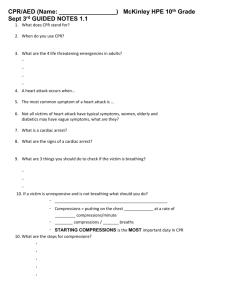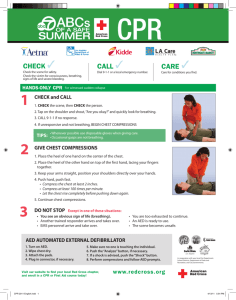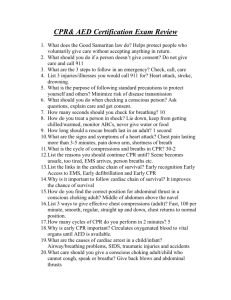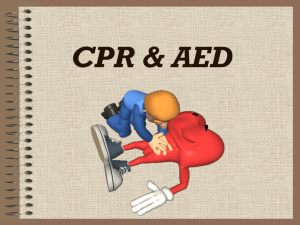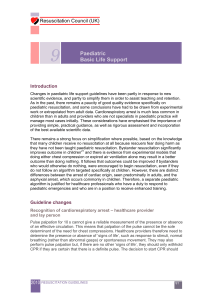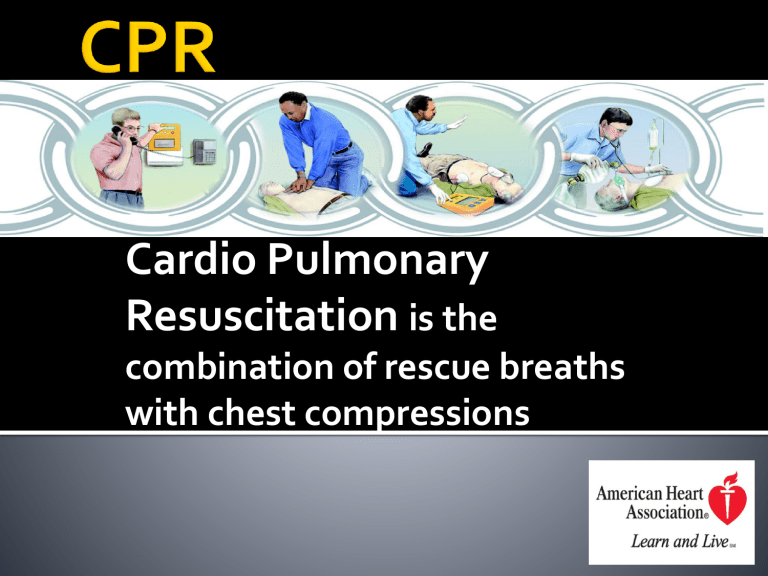
Cardio Pulmonary
Resuscitation is the
combination of rescue breaths
with chest compressions
The terminal state is a critical level of
impairment of vital activity with a
pronounced drop in blood pressure, a deep
violation of gas exchange and metabolism
Clinical death is the moment of complete
arrest of blood circulation and respiration.
Biological death is an irreversible cessation
of physiological processes in cells and tissues.
Cardio-pulmonary resuscitation
Why It is Important ?
The duration of clinical death is 3-5 minutes!
After 5-7 minutes after the onset of clinical
death, brain destruction begins.
After 10 min. irreversible changes occur,
leading to biological death.
CPR - Cardio Pulmonary Resuscitation
procedure to support and maintain breathing and
circulation for a victim who has stopped breathing
(respiratory arrest) and/or whose heart has stopped
(cardiac arrest).
CLINICAL SIGNS OF STOPPED
BLOOD CIRCULATIONS:
LACK OF CONSCIOUSNESS
NO NORMAL RESPIRATION OR AGONAL
BREATH
NO PULSE
Check
Call
Care
Check for anything unsafe, such as spilled
chemicals, traffic, fire, and other hazardous
items.
Are you putting yourself in danger by helping
this person? Make sure you are also taking
care of yourself.
Is there anyone around who can also help?
Ask others around the scene for as much help
as they can offer
Check for responsiveness: tap and shout
Calling for help is often the most important action
you can take to help the person
Call 112 or the local emergency number(if there are
other people at the scene, ask someone else to call
for you to help !
Make sure you give the 112 operator correct
information about your location, the emergency,
any other information you are able to give about the
emergency
Do not further harm.
Monitor the person’s breathing and
consciousness.
Help the person rest in the most comfortable
position.
Keep the person from getting chilled or
overheated.
Reassure the person
STEP 1: {C} Start compression (100 / min)
COMPRESSIONS (INDIRECT MASSAGE)
Without initial breaths (!) 30 compressions (then - 2 breaths)
Hands are placed on the middle of the chest, fingers are crossed.
STEP 2: {A} OPEN THE AIRWAY
{A} AIRWAYS
Triple technique:
• tilt the head backward
• open the mouth
• extend the lower jaw
BUT: It is inacceptable if you
suspect a cervical spine trauma
(car accidents, falls, sport injuries)!
СЕРДЕЧНО-ЛЕГОЧНАЯ РЕАНИМАЦИЯ
STEP 2: {A} AIRWAY
{A} AIRWAYS
The extension of the mandible (jaw-thrust)
is one of the most effective components.
Signs of effectiveness of CPR.
Every 1-2 min - pulse control
on the carotid artery.
• Reappearance of pulse on carotid artery
• Reaction of pupils to light
• Improved skin colour.
• Attempts of spontaneous breathing
• Voluntary limb movements
Automatically checks victim’s
heart rhythm to detect
fibrillation
Advises whether victim needs a
shock
- the shock (defibrillation) is an
attempt to return heart to a
normal rhythm.
Algorithm
USE AN AED
(AUTOMATED EXTERNAL DEFIBRILLATOR)
• As soon as the AED is delivered to the scene:
• enable the AED and then follow its voice and visual commands;
• impose electrodes on the patient's bare chest.
One electrode is placed on the
right side of the chest (under
the collarbone, to the right of
the sternum, not on the
sternum!).
The second electrode is applied
to the left half of the chest.
Algorithm
USE AN AED
(AUTOMATED EXTERNAL DEFIBRILLATOR)
• If there is a second
rescuer during the
imposition of the
electrodes,
continuous chest
compressions
should be continued.
Algorithm
USE AN AED
(AUTOMATED EXTERNAL DEFIBRILLATOR)
make sure that no one touches
the patient, and press the
button;
immediately after the
application of the discharge,
continue the CPR in the ratio of
30: 2
AED
(AUTOMATED EXTERNAL DEFIBRILLATOR)
в метро (Мюнхен)
аэропорт Скипол (Амстердам)

